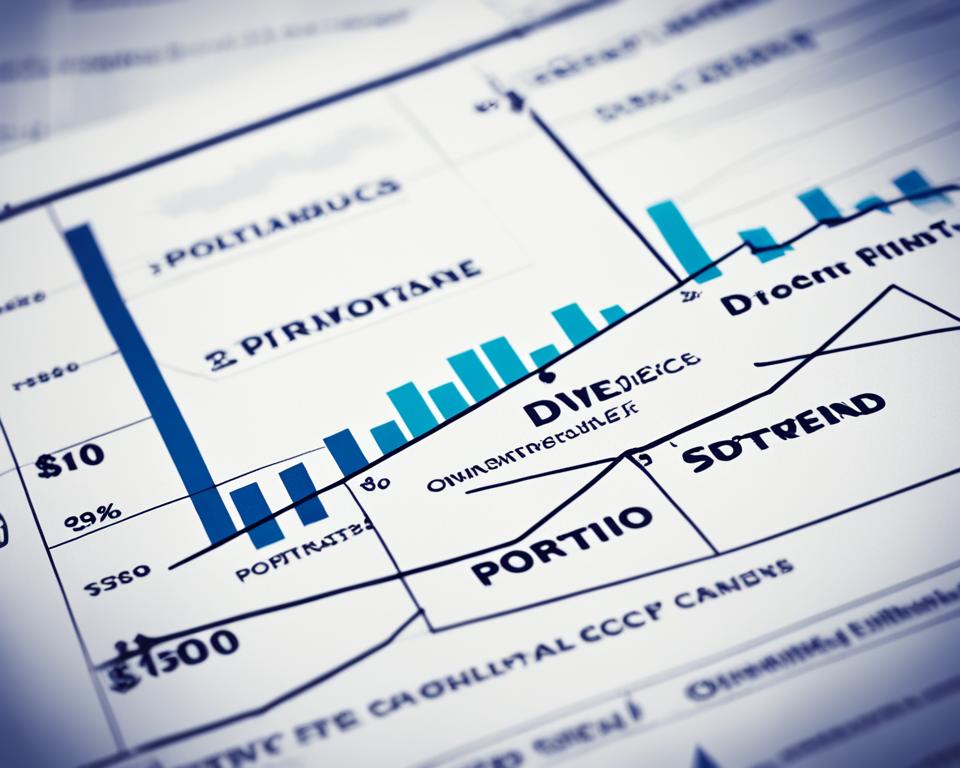For individuals managing a dividend portfolio, the road to financial optimization can sometimes involve removing stocks from a dividend portfolio, invoking strategies of dividend portfolio management, or even full portfolio divestment. These decisions are spurred by a desire to enhance the value of their holdings and optimizing dividend yields. It’s not just about what assets one collects; often, the stocks an investor chooses to exclude can make a significant difference in portfolio performance. The fine-tuning of investments requires a deep understanding of market dynamics, investment timelines, and individual financial goals.
Whether it’s about trimming positions that no longer generate desired returns or strategically offloading assets during market peaks, astute investors craft their approach to ensure their portfolio remains robust and resilient. By striking a careful balance between accumulation and divestiture, investors navigate through fluctuating markets, aiming to drive consistent income and capital growth over the long term.
Key Takeaways
- Understanding the impact of removing stocks from a dividend portfolio is critical for managing long-term investment health.
- Dividend portfolio management involves strategic analysis to maximize returns and minimize risks.
- Portfolio divestment can play a significant role in shaping the yield profile and stability of an investment portfolio.
- Optimizing dividend yields may necessitate cutting loose underperforming assets to better position for growth.
- A precise blend of holding steadfast and knowing when to let go defines the savvy investor’s path to financial success.
Understanding Dividend Portfolio Management
The art of building and maintaining a dividend portfolio extends beyond merely cherry-picking high-yield stocks. Successful investors need to weigh the role of dividends within their broader investment strategy and continually assess how these regular payouts influence their financial trajectory. Dividends can fuel portfolio growth through reinvestment or serve as a source of steady income, depending on the individual’s stage in the investment lifecycle and economic goals. Moreover, the nuances of a stock removal strategy must not be overlooked, as it plays a critical role in optimizing dividend yields.
The Role of Dividends in an Investment Strategy
Dividends are more than just a passive income stream; they are a pivotal component of a holistic dividend investment strategy. The decision to focus dividends towards reinvestment or as direct income impacts not only an investor’s immediate financial needs but also their long-term market position. Dividends that are reinvested purchase more shares, harnessing the power of compounding to escalate future earnings potential.
Dividend Reinvestment vs. Income Generation
In considering dividend reinvestment against income generation, investors position themselves along a spectrum that balances growth with liquidity. Reinvestment is a hallmark for cultivating wealth over time, with the added advantage of acquiring more shares without incurring transaction costs. Conversely, opting for direct income generation can provide accessible funds for current expenses, particularly attractive for retirees who prioritize a consistent cash flow.
Assessing Portfolio Performance Over Time
Measuring the effectiveness of a dividend portfolio over time is instrumental in ensuring it meets set financial objectives. Investors must consider a range of factors such as the volatility inherent in their selections, the returns on their investments, and the degree of diversification within the portfolio. This assessment isn’t merely a retrospective activity; it’s a forward-looking tactic, guiding future decisions on whether to pursue further reinvestment or to adjust strategies with the objective of optimizing dividend yields.
| Strategy | Advantages | Considerations |
|---|---|---|
| Dividend Reinvestment |
|
|
| Income Generation |
|
|
Ultimately, the dichotomy between reinvesting dividends and allocating them as income speaks to the core of an investor’s goals and the evolving market conditions. For those dedicated to expanding their portfolio, strategically employing a stock removal strategy can be as substantial as seeking avenues to acquire more shares. Every step taken, whether adding or removing assets, is a stride towards optimizing dividend yields and realizing financial aspirations.
Evaluating Total Returns for Dividend Stocks
When it comes to optimizing dividend yields and effective dividend portfolio management, a key measure of success is evaluating the total returns of dividend stocks. Total returns encompass not only the dividend payments received but also the capital gains achieved through the appreciation of the stock’s price. This composite measure provides a comprehensive overview of an investment’s performance and is critical when considering the addition or removal of stocks from a dividend portfolio.
A critical aspect is the variation in performance across different dividend stock benchmarks. While standard stock market indexes may convey a homogeneous picture, dividend stock indexes often present a plethora of outcomes shaped by varied criteria set by the index providers. This array of methodologies – ranging from wider market scope to more focused approaches like high yield selection or quality screening – impact the total returns and, consequently, the process of dividend portfolio management.
To gain a nuanced understanding of the potential for optimizing dividend yields, let’s delve into comparative data that underscores these variances and their implications on portfolio performance. A diversified mix of dividend strategies, backed by historical analysis, can reveal trends and inform decisions that align with investors’ long-term objectives.
| Index Approach | Yield Emphasis | Quality Focus | Historical Returns | Volatility Measurement |
|---|---|---|---|---|
| Broad Market | Moderate | Low | Steady, consistent growth | Comparable to market average |
| High Yield | High | Varies | Potentially higher returns | Higher, due to risk concentration |
| Quality Screened | Varies | High | Stability with moderate growth | Lower, due to quality emphasis |
Evaluating the health of dividend-paying companies is another cornerstone of assessing total returns. It is essential to acknowledge that a stock’s historical dividend performance is not a guaranteed predictor of future outcomes. Therefore, investors must exercise due diligence, tracking the financial strength and market standing of the companies within their portfolios. Only by such careful scrutiny can one effectively apply strategies aimed at optimizing dividend yields.
Patience plays a crucial role in dividend portfolio management, as investment strategies that have weathered the test of time may not yield immediate results. Nevertheless, by remaining steadfast in evaluating total returns with a keen eye on historical data and market trends, investors can make informed decisions that enhance their portfolio’s yield potential.
Adding Stocks for Higher Portfolio Yields
In the landscape of dividend investing, individuals are constantly in pursuit of strategies to elevate their portfolio yields. Central to this mission is the identification and incorporation of stocks that not only promise high yields but also contribute positively to the overall health and stability of their dividend portfolio. This strategic inclusion, done thoughtfully, involves balancing the allure of high dividends with a meticulous evaluation of the associated risks.

In the quest for favorable returns, a dividend investment strategy that is well-rounded and prudent can be significantly impactful. It often involves a deft application of a stock removal strategy, replacing underperforming stocks with more lucrative prospects. Identifying high-yield opportunities while simultaneously considering the broader market and financial indicators, thereby, becomes a crucial skill for savvy investors.
Identifying High-Yield Opportunities
Spotting high-yield opportunities requires a keen eye for both current and potential future performance of dividend-paying stocks. The search for these opportunities can often lead investors towards industries and sectors that have historically demonstrated both resilience and generosity in dividend payouts. Notably, sectors such as utilities, consumer staples, and real estate investment trusts (REITs) can often offer the robust dividends that yield-focused investors seek.
Balancing High Yields with Risk Considerations
The process of yielding dividends is not devoid of risk, particularly when high payouts might signal deeper company issues or a bet on market volatility. Thus, balancing high yields with risk considerations entails a composite assessment that goes beyond the surface level metrics. It is critical to gauge the company’s ability to maintain and potentially grow its dividend payouts, considering factors such as earnings stability, debt levels, and the overall economic environment.
Conscientious investors often establish quality screens to aid in their selection, which consist of key financial ratios and performance indicators. These screens assist in differentiating between companies that are genuinely thriving and those whose high yields could be a façade for underlying troubles.
To illustrate this balance, below is a table which demonstrates how investors may weigh various elements when selecting high-yield stocks for their portfolio.
| Stock Selection Criteria | High-Yield Prospects | Risk Assessment |
|---|---|---|
| Dividend Yield Percentage | Attractive high-yield figures, often above the market average. | Yields must be sustainable and not compromise the company’s financial health. |
| Payout Ratio | Moderate to ensure dividends are well-covered by earnings. | Too high a ratio could indicate potential cuts in future dividends. |
| Debt-to-Equity Ratio | Preferably low, to indicate the company is not overleveraged. | High levels of debt can jeopardize dividend sustainability. |
| Earnings Growth | Consistent upward trajectory. | Declining earnings may lead to a decrease in dividend payouts. |
Ultimately, the goal is to foster a dividend investment strategy that is resilient, remunerative, and adjusted to market realities. The addition of well-chosen high-yield stocks can indeed be the fuel that propels portfolio performance to new heights—provided it’s done with a careful and discerning approach that weighs every potential high-yield opportunity against its innate risk profile.
Reducing Portfolio Volatility with Dividend Stocks
The quest for a steadfast investment strategy often leads to the utilization of dividend stocks, known for their potential to anchor a portfolio amidst the ebbs and flows of market tides. Among the numerous tactics employed to safeguard investments, cultivating a robust array of dividend-paying stocks stands out as a key method for reducing portfolio volatility. The relatively predictable nature of dividend disbursements provides an element of consistency that can be instrumental in smoothing the peaks and valleys of portfolio performance.
Within the broad tapestry of investment opportunities, dividend stocks serve not just as vessels of potential gains, but also as buffers against the unpredictability inherent to financial markets. The careful selection of these assets—factoring in frequency, yield, and the reliability of dividend payments—complements the primary goal of solidifying an investor’s position against unpredictable market movements and fostering long-term stability.
The Connection Between Dividends and Volatility
It is well-documented that dividend-paying stocks often exhibit less volatility compared to their non-dividend-paying counterparts. This phenomenon is underpinned by the psychological comfort that consistent returns provide to investors, who may otherwise react hastily to market fluctuations. Moreover, companies that can sustain regular dividend payments are typically viewed as financially stable, instilling further confidence among shareholders and contributing to a more stable stock valuation over time.
Portfolio Diversification and Safety Stocks
Integrating dividend stocks into a diversified portfolio is akin to weaving a safety net that captures potential falls. Not only do dividends contribute to a reduction in volatility, but the strategic inclusion of safety stocks—such as those from sectors like utilities and consumer staples—adds another layer of protection. These are sectors where demand remains steady regardless of economic highs and lows, thus providing a dependable flow of income. When portfolio diversification is thoughtfully executed, with an emphasis on incorporating safety stocks, an investor is well-equipped to combat market volatility while still pursuing satisfactory returns.
| Sector | Characteristic | Dividend Reliability | Contribution to Portfolio Stability |
|---|---|---|---|
| Utilities | Stable demand, regulated | High | Significant |
| Consumer Staples | Inelastic demand | High | Significant |
| Health Care | Essential services | Moderate to High | Moderate |
| Real Estate (REITs) | Asset-backed, consistent rent revenue | Moderate to High | Moderate |
In conclusion, the pursuit of reducing portfolio volatility can be substantially supported by the strategic selection of dividend stocks. Through careful curation, investors can harness the stability that dividends offer, while providing a canvas for profit in a well-rounded financial portfolio.
Assessing Company Health Before Removing Stocks from a Dividend Portfolio
Dividend portfolio management demands a careful, analytical approach, especially when considering divesting from underperforming stocks. Investors aiming to optimize their holdings need to thoroughly scrutinize the financial health and projected trajectory of the companies they are invested in. Assessing the vitality of a business can ascertain whether a drop in stock performance is merely a temporal hurdle or a sign of chronic underperformance warranting strategic portfolio divestment.
Key indicators play a pivotal role in this evaluation. Financial stability, for instance, can be gauged through balance sheets and cash flow statements which highlight the company’s solvency and operational efficiency. Earnings consistency over several quarters offers insights into the sustainability of dividend payments. The potential for growth informs whether the company can scale operations and increase shareholders’ value. It is this mix of quantitative benchmarks and qualitative foresight that shapes a prudent divestment strategy.
The following table represents a guide to assessing core financial aspects before deciding on divestment:
| Financial Aspect | Description | Relevance to Divestment |
|---|---|---|
| Earnings Growth | Comparison of current and past earnings to indicate growth trajectory. | An underperforming or stagnant earnings growth could signal divestment considerations. |
| Debt-to-Equity Ratio | Company’s financial leverage and use of debt to finance its operations. | A high ratio may indicate financial instability and might be a point for portfolio divestment. |
| Dividend History | Record of dividend payouts and any changes over time. | Erratic or diminishing dividends might trigger divestment to protect portfolio yield. |
| Cash Flow Stability | Robustness of the company’s cash inflow against its obligations. | Unstable cash flow can endanger dividend payments and suggest potential divestment. |
Investors must also consider broader economic conditions and business cycles which may affect sector performance. For example, a cyclical downturn could temporarily depress stock prices without necessarily reflecting a company’s health. This is where knowledge of sector-specific risks, such as regulatory changes or raw material cost fluctuations, factor into making informed decisions on the timing and extent of portfolio divestment.
Strategic portfolio management, then, is not a knee-jerk response to market noise but rather an informed decision borne of comprehensive analysis. Dividend portfolio management involves continuous monitoring and weighing various market and company-specific indicators. By thoroughly vetting their options, investors can ensure their divestment moves contribute positively to the long-term resilience and yield of their portfolios. This includes knowing when to hold steadfast and when to let go based on informed assessments rather than market speculation or fleeting trends.
The Impact of Market Conditions on Dividend Stocks
The performance of dividend stocks does not occur in isolation; it is intimately connected to the ever-shifting landscape of the market conditions. The vigilant investor, attuned to the subtleties of these conditions, finds themselves better positioned for optimizing dividend yields. By dissecting the flow of economic indicators and assessing the broader financial environment, one can anticipate the influence of market movements on dividend stability and growth.

Anticipating Market Trends
Being proactive in anticipating market trends unveils valuable insights that influence dividend portfolio strategies. The crux of this anticipation lies in identifying patterns and signals that presage sector-specific booms or downturns. For dividend-centric investors, particularly attuned to sectors such as utilities and consumer goods, recognizing these signs can lead to preemptive adjustments intended to safeguard and enhance yields.
Adapting to Economic Cycles
Integral to the success of dividend investing is the ability to adeptly navigate through the various phases of economic cycles. Expansionary phases often lead to burgeoning dividend payouts, while more defensive positions may prove beneficial during economic contractions. Thus, the strategic investor tailors their portfolio to not only withstand these cycles but to capitalize on the opportunities they present. This entails a dynamic balancing act between seeking growth during prosperous times and securing income during leaner periods.
| Economic Phase | Implications for Dividend Stocks | Strategy for Optimizing Yields |
|---|---|---|
| Expansion | Growth-oriented sectors may increase dividends. | Target growth sectors for higher potential payouts. |
| Peak | Possible overheating could stall dividend growth. | Consider securing gains and reassessing stock positions. |
| Contraction | Defensive sectors tend to sustain dividend outputs. | Shift focus to defensive stocks with consistent dividends. |
| Trough | Low valuations could offer entry points for yield maximization. | Identify undervalued stocks with stable dividend prospects. |
As market winds shift, adapting strategies to align with the prevailing economic cycles plays a substantive role in maintaining and optimizing dividend yields. Investors must monitor not only the stocks within their grasp but also the vast horizon of market forecasts to truly thrive in the dynamic world of dividend investing.
Removing Stocks from a Dividend Portfolio Due to Underperformance
The prudent management of a dividend portfolio often requires the implementation of a strategic stock removal strategy, particularly when certain assets are hindering the portfolio’s capacity for growth. Discerning investors recognize the necessity of divesting from underperforming stocks to mitigate potential losses and optimize long-term yields. Regular performance reviews can elucidate which stocks may be detrimental to a portfolio’s health, taking into account factors such as consistent underperformance, diminishing dividend returns, and adverse industry shifts.
Chronic underperformance in stocks poses the question of allocation efficiency within a portfolio. Staying invested in lagging assets can drag down overall performance metrics, potentially leading to an imbalanced investment approach. The identification and removal of such stocks are thus essential actions for maintaining a healthy and dynamic portfolio.
When reviewing a dividend stock’s performance, it is worth noting both contemporaneous and historical context. Benchmarks and averages provide a standard against which individual stocks can be measured, offering investors insight into both the stock’s individual trajectory and its performance in relation to the broader market.
| Factor | Indicator of Underperformance | Action Point |
|---|---|---|
| Dividend Yield Drop | A sustained decrease in dividend yield compared to historical averages | Investigate the cause for decline and consider divesting |
| Relative Performance | Consistent underperformance against sector benchmarks | Assess future prospects and potential for recovery or divest |
| Earnings Deterioration | Earnings reports indicating a decline or stagnation | Evaluate earnings trends and potential impact on dividends; divest if unfavorable |
| Industry Health | Negative outlook or decline in the broader industry sector | Divest from stocks in suffering sectors likely to affect dividend payouts |
The process of purging underperforming elements from one’s investments should, however, be approached with careful consideration. Factors leading to a stock’s poor performance must be thoroughly analyzed, distinguishing between temporary drawbacks and fundamental weaknesses. A deliberate and judicious application of a stock removal strategy provides an investor with the means to safeguard and potentially elevate their investment’s potential.
Incorporating these vital steps into dividend portfolio management ensures that investments continue to contribute positively towards the overarching goal of stable growth and optimized yields. The dynamic act of investing is as much about knowing when to divest as it is about selecting assets, allowing the investor to remain agile and prosperous in an ever-evolving market landscape.
Portfolio Divestment Strategies
In the dynamic world of investing, effective portfolio divestment can be as critical as the initial selection of stocks. The decision to engage in full or partial divestment from one’s holdings is multifaceted, influenced by an array of factors that range from market conditions to shifts in corporate health and strategy. Discerning when and how to detach from certain stocks is not only about safeguarding investments; it’s about enhancing the portfolio’s ability to meet future financial goals. Mastering the art of the stock removal strategy entails both an acute understanding of one’s investment objectives and a strategic approach to timing the market.
Considerations for Partial vs. Full Divestment
Partial divestment acts as a strategic tool, enabling investors to rebalance their portfolios or recalibrate their exposure to specific sectors or assets. Such granular adjustments are often made in response to performance assessments of individual stocks or to maintain a certain risk threshold. In contrast, a full divestment might be on the table when there are radical changes in a company’s prospects or market conditions, signaling the potential for a drag on overall portfolio performance.
| Divestment Type | Common Scenarios | Potential Benefits |
|---|---|---|
| Partial | Rebalancing, sector overexposure, performance optimization | Minimizes impact on portfolio balance, maintains diversification |
| Full | Corporate decline, fundamental strategy shift | Reduces potential losses, reallocates capital to promising opportunities |
Timing the Market: When to Divest
While the timing of entry into the stock market often garners much attention, the exit strategy is equally significant. Astute investors strike when conditions align with their investment horizon and risk profile. They remain vigilant to indicators such as company earnings reports, economic forecasts, and sector trends, using these insights to decide on the timing of divestments. With the correct timing, investors can not only prevent losses but could also harvest gains that contribute to the overarching resilience and growth of their portfolios.
- Monitoring economic indicators for signs of downturns or sector weakness
- Assessing company-specific signals, such as drastic leadership changes or regulatory impacts
- Evaluating portfolio performance against benchmarks to identify lagging assets
While there is no perfect formula for timing the market, a combination of due diligence, strategic thinking, and an attuned sense of market rhythms can enhance investors’ ability to make decisive and profitable portfolio divestment choices.
Dividend Investment Strategy: Rebalancing for Optimization
Within a successful dividend investment strategy, rebalancing portfolio components is vital to align with the shifting dynamics of the market and an investor’s overarching financial goals. The act of rebalancing is more than a routine check-up; it’s a strategic fine-tuning to ensure sustained growth and risk management. Balancing outperforms stock allocations with under-represented assets, thus maintaining a well-rounded and diversified investment landscape. This intentional effort helps mitigate risks and aims to enhance profitability by avoiding overexposure to single stocks or sectors, which can prove detrimental during market downturns.

The holistic approach to rebalancing recognizes that as certain stocks advance in value, they begin to represent a larger proportion of the portfolio than initially intended—a situation that might not align with the predetermined risk appetite. Shrewd investors periodically realign to the original or updated asset allocation plans by securing profits from winners and reinvesting in areas with untapped potential. This tactical move not only locks in gains but fosters portfolio diversification, often leading to improved long-term returns.
The concept of rebalancing can be punctuated with a side-by-side comparison that reflects hypothetical portfolio adjustments. For illustrative purposes, consider the following table, which demonstrates a simplified version of rebalancing actions:
| Portfolio Action | Objective | Impact on Diversification |
|---|---|---|
| Selling overvalued stocks | Capture gains and reduce concentration risk | Decreases exposure to a single asset, fostering a balanced investment spread |
| Investing in undervalued sectors | Utilize growth potential in overlooked market areas | Broadens scope within portfolio, introducing new growth vectors |
| Increasing allocation to dividend achievers | Bolster steady-income generating assets | Strengthens the foundation for consistent cash flows, adds stability |
It’s essential to recognize the signs that indicate a need for rebalancing—a skill that involves tracking both market movements and individual financial aspirations. Parameters such as deviations from targeted asset allocations, significant market changes, or shifts in personal risk tolerance are signals that it may be time to reassess and reroute the investment course.
Ultimately, the continuous rebalancing of a dividend portfolio is not just about preservation; it’s an assertive strike towards value generation and portfolio diversification that can pave the path to fiscal prosperity.
Understanding Tax Implications When Removing Stocks
For investors, an essential aspect of managing a dividend portfolio is understanding the tax implications that come with removing stocks. Decisions to divest from certain dividend-yielding stocks should be scrutinized not only for their financial implications but also for their tax consequences. An investor’s strategy for tax-efficient dividend investing must consequently be comprehensive, taking into account the different tax treatments of various dividends and how these affect overall portfolio performance.
Qualified dividends, for instance, benefit from lower tax rates, an advantage that demands a certain holding period. Non-qualified dividends, on the other hand, are taxed at the investor’s ordinary income tax rate. Recognizing the timing and the nature of dividend income is therefore pivotal in planning divestments in a way that preserves the portfolio’s after-tax return.
Tax-efficient Dividend Investing
Awareness of the opportunities around tax-efficient dividend investing enables investors to maximize the impact of their carefully selected dividend portfolios. This strategic approach involves recognizing the benefits of holding stocks for the long-term to qualify for improved tax treatment on dividends. Furthermore, tax-conscious investors often incorporate holdings across various asset classes and accounts, including tax-deferred or tax-free vehicles such as IRAs or Roth IRAs, to optimize the tax implications of their investment decisions.
It’s also important to consider the timing of divestiture to manage tax liability appropriately. For example, selling stocks just before dividend payments could result in missed opportunities for lower-tax qualified dividends. Hence, staying apprised of payment schedules and cutoff dates becomes integral to tax-efficiency.
Impact of Dividend Income on Taxation
The impact of dividend income on taxation extends beyond the rate at which dividends are taxed. Realized capital gains from the sale of dividend stocks also contribute to an investor’s tax liabilities. Long-term capital gains, like qualified dividends, are subject to favorable tax rates—yet another reason why the timing of stock removal in a dividend portfolio carries weight in the broader scope of tax planning.
On the other hand, if a portfolio includes stocks that distribute substantial non-qualified dividends, investors may observe a proportional increase in their tax burden. Therefore, understanding the nuances of dividend distributions across a portfolio is fundamental when considering the sale of assets, enabling prudent decisions that maintain a portfolio’s favorable tax status.
In conclusion, a comprehensive approach to portfolio management must incorporate elements of tax planning, especially when divestment is on the horizon. By integrating tax considerations into the fabric of investment strategies, particularly regarding tax-efficient dividend investing and the impact of dividend income on taxation, investors can safeguard the after-tax performance of their portfolios and secure their financial future.
Using DRIPs to Increase Long-term Value in Your Portfolio
For the savvy investor focused on increasing long-term value, utilizing Dividend Reinvestment Plans (DRIPs) can serve as a catalyst for accelerating portfolio growth. These plans enable the automatic reinvestment of dividends into purchasing more shares of the company. The essence of DRIPs lies in their capacity to facilitate the process of accumulating shares without the hassle of manual reinvestment—and often these purchases come with the advantage of discounted prices or commission-free transactions.
The use of DRIPs is a testament to the power of compounding returns. As dividends are reinvested, they don’t just add to the share count—they themselves earn dividends, creating a cycle of growth that compounds over time. This strategy is especially potent for those envisioning a future where their current investments form the backbone of their financial stability.
The incremental accumulation of shares through dividend reinvestment plans becomes a game changer when viewed through the lens of investment horizons. The methodology not only elevates the long-term value of a portfolio but also instills a disciplined approach to (re)investing—an approach less swayed by the often-temporal sentiments of market fluctuations.
| DRIP Feature | Long-term Growth Benefit |
|---|---|
| Automatic Reinvestment | Facilitates continuous growth without the need for investor intervention |
| Fractional Shares | Enables full investment of dividends, optimizing share accumulation |
| Discounted Shares | Lowers the cost basis, enhancing the investment value over time |
| Compounding Effect | Amplifies the return potential as reinvested dividends compound |
In addition to the purely numerical advantages, DRIPs proffer distinct administrative ease. By using DRIPs, investors can avoid the cost and effort associated with timing the market—instead, they participate in a process oriented towards steadfast growth. They embody a forward-thinking mindset, implicitly endorsing the philosophy that steadfast investing, rather than reactive trading, charts the course to a prosperous financial future.
An investor keen on increasing long-term value and optimizing dividend yields finds in dividend reinvestment plans a partnership of convenience and growth potential. Through DRIPs, the journey towards fiscal growth is not contingent on striking at market highs and lows but is navigated through the steady accretion of assets that time, not timing, proves to be the ultimate ally.
Reviewing Portfolio Diversification After Adding or Removing Stocks
Adjustments in an investment portfolio, such as adding or removing stocks, necessitate a reviewing portfolio diversification to preserve its integrity and efficacy. This involves meticulously analyzing portfolio balance and re-evaluating risk to ensure the changes align with the investor’s objectives and do not inadvertently skew the portfolio’s risk profile.
Analyzing the Effect on Portfolio Balance
A balanced investment portfolio is akin to a well-tuned orchestra where each instrument contributes to the harmonic whole. When stocks are added or subtracted, it’s imperative to analyze their effect on the overall balance. This process might include examining the weight of different sectors or asset classes, assessing the influence on the investment’s thematic focus, and confirming that the portfolio’s composition remains in harmony with strategic investment goals.
For instance, the addition of tech stocks may need to be offset by investments in more stable, income-oriented assets to maintain equilibrium. Similarly, removing high-volatility stocks might necessitate the inclusion of assets that provide a similar growth potential with moderated risk, to prevent the portfolio from becoming overly conservative.
Re-evaluating Risk After Portfolio Adjustments
Portfolio adjustments carry inherent risk implications that must be re-evaluated to safeguard against unforeseen exposures. This re-evaluation considers both systemic risks that affect the market at large and unsystematic risks unique to individual securities. An overconcentration in one sector or an inadvertent lean towards a particular risk level can disrupt a portfolio’s trajectory, potentially steering it away from consistent, long-term returns.
For example, expanding into emerging markets may offer high growth potential but also brings increased political and currency risk. Conversely, divesting from volatile sectors, such as energy, may reduce risk, yet also limit possible outsized gains from market rebounds in those sectors.
In summation, the process of adding or removing stocks should be followed by diligent reassessment to ensure portfolio harmony. By periodically reviewing portfolio diversification, analyzing portfolio balance, and re-evaluating risk, investors can adeptly navigate through the complexities of portfolio management, setting their sights on a well-diversified and balanced path to achieving their investment goals.
Deciding Between Cash Flow and Reinvestment of Dividends
Investors facing the crossroads between allocating dividends for immediate cash flow or reinvesting them face a pivotal decision with lasting implications. This choice should be harmonious with one’s financial goals, the need for effective cash flow management, and the ideal balance between risk and return. Depending on individual financial strategies and stages in life, the benefits of one option may outweigh the other.
Pros and Cons of Reinvesting Dividends
The allure of reinvesting dividends lies in the promise of compounding growth. By choosing to reinvest dividends, investors leverage their ability to accumulate more shares over time, potentially magnifying the value of their portfolio. Automatic enrollment in Dividend Reinvestment Plans (DRIPs) further simplifies this process, eliminating transaction fees while nurturing an investment’s expansion.
| Advantages of Reinvesting | Challenges of Reinvesting |
|---|---|
|
|
Conversely, there are consideration points on remaining liquid with dividends, especially for those at or nearing retirement. The decision is ultimately a balance of cash flow management needs versus the aspiration for portfolio growth.
Financial Goals and Cash Flow Management
Aligning investment actions with personal financial goals is key to deciding between taking dividends as cash or reinvesting them. Investors aiming for steady income streams to cover ongoing expenses or who prefer ready-access liquidity may favor receiving cash dividends. Meanwhile, those with a long-term growth mindset or in earlier stages of wealth accumulation might see the prospect of reinvesting dividends as a means to maximize future returns.
| Financial Situation | Preference for Cash Dividends | Preference for Reinvesting |
|---|---|---|
| Approaching/In Retirement | Immediate income to fund living expenses | Continue growth if other income sources are sufficient |
| Mid-Career, Accumulating Wealth | Liquidity for other investment opportunities | Build portfolio through compound growth |
| Early-Career, Long-term Focus | Rare, may prefer flexibility for short-term goals | Generally preferred for maximizing compound interest effects |
In reviewing their dividend investment strategy, investors should weigh the advantages of reinvesting dividends, such as compound growth, against the need for cash flow management to support current or near-term financial goals. This strategic thinking propels the crafting of a well-tuned portfolio, conducive to the investor’s financial well-being.
Conclusion
Mastering dividend portfolio management is a multifaceted endeavor, central to which is the astute application of a stock removal strategy. Investors striving for optimizing dividend yields must meticulously juggle various factors. Intertwining total returns, volatility, company health, and market conditions with the nuances of tax implications and individual investment goals creates a symphonic balance that, if hit correctly, can escalate the trajectory of a portfolio. The amalgamation of these elements translates into an overarching strategy that marries the allure of high-yield prospects with a measured approach to risk.
As we have discussed, the decisions to add or cut loose certain stocks are never to be taken lightly. Each move must be weighed against its potential to enhance or hinder a portfolio’s yield and growth. Through continuous evaluation of performance, diligent diversification, and strategic rebalancing, investors can keep their portfolios aligned with their objectives. The journey through the ever-evolving landscape of the economy also requires adaptability—a quality that allows investors to pivot as conditions change, seeking always to refine and augment the vitality of their dividends.
In summary, the path to optimizing dividend yields is carved with disciplined portfolio management, informed decision-making, and an openness to adapt as market conditions transform. By embracing these pillars of savvy investing, shareholders can harness the full potential of their dividend-bearing assets, propelling towards a future of fiscal prosperity. Whether it’s through the calculated removal of certain stocks or the vigilant selection of new additions, each action contributes to the finessed art of portfolio optimization, ensuring that every dividend plays its part in the grand financial symphony.
FAQ
What Should Be Considered When Adding or Removing Stocks From a Dividend Portfolio?
When managing a dividend portfolio, it’s crucial to evaluate factors such as overall portfolio yield, the financial health of the companies, sector diversification, and how changes align with investment goals. Decisions on portfolio divestment should consider potential impacts on optimizing dividend yields and the long-term growth or income generation goals of the portfolio.
How Do Dividends Affect Investment Strategy?
Dividends can serve as a source of steady income or be reinvested to grow the number of shares held, which can significantly contribute to the compounding of returns over time. The choice between dividend reinvestment and income generation can alter the trajectory of portfolio growth or the level of cash flow available to the investor.
Why Is Assessing Portfolio Performance Over Time Important?
Monitoring portfolio performance helps investors understand how their investment strategy fares against benchmarks, assess the progression towards financial goals, and adapt strategies as needed to address changing market conditions or personal financial objectives.
How Are Total Returns for Dividend Stocks Evaluated?
Total returns for dividend stocks are assessed based on the dividends paid out and the capital appreciation of the stocks. Evaluating these returns requires a look at historical performance, the current financial status of the companies involved, and how these fit within the broader market trends.
What Are Some Strategies for Adding High-Yield Stocks to a Portfolio?
When seeking to add high-yield stocks to a portfolio, investors should use quality screens to select financially stable companies with favorable long-term prospects and ensure these selections contribute to a balanced investment strategy that does not overly concentrate risk in high-yield but potentially volatile securities.
How Can Dividend Stocks Reduce Portfolio Volatility?
Dividend-paying stocks are often considered less volatile as they provide regular income, which can help stabilize a portfolio during market dips. Incorporating such stocks, particularly from sectors with consistent demand, can help to mitigate overall investment risk.
What Are Key Indicators of Company Health in a Dividend Portfolio?
Important indicators include consistent and sustainable dividend payments, solid earnings growth, robust financial fundamentals, and the company’s market position within its industry.
Why Is It Important to Anticipate Market Trends When Managing a Dividend Portfolio?
Anticipating market trends allows investors to potentially foresee shifts that could impact the performance of dividend-paying stocks, which helps in making proactive adjustments to the portfolio to maximize returns or minimize loss.
When Should an Investor Consider Removing Underperforming Stocks From Their Dividend Portfolio?
Stocks should be considered for removal if they exhibit sustained underperformance that may affect the portfolio’s growth potential or yield, especially when the underperformance is due to fundamental issues within the company or industry that are unlikely to be resolved in the near term.
What Are Some Effective Divestment Strategies for a Dividend Portfolio?
Effective divestment strategies might involve partial or full sale of holdings, considering the timing of sales to align with market movements and economic indicators, and executing divestments in a manner that supports the broader investment objectives.
What Tax Considerations Should Be Accounted for When Removing Stocks?
When divesting stocks, it’s important to understand the tax implications, such as the difference between qualified and non-qualified dividend income, and how capital gains taxes may affect the net returns of the investment.
How Can DRIPs Increase the Long-term Value of a Dividend Portfolio?
Dividend Reinvestment Plans (DRIPs) automate the process of reinvesting dividends into additional shares, taking advantage of compounding and potentially allowing investors to purchase shares at discounted rates which can lead to significant growth in portfolio value over time.
Why Is Reviewing Portfolio Diversification Crucial After Portfolio Adjustments?
After adding or removing stocks, reviewing portfolio diversification ensures that the portfolio remains balanced and aligned with the investor’s risk tolerance and investment objectives. It also helps to prevent overexposure to certain sectors or styles of investing that could unduly increase risk.
How Should Investors Choose Between Reinvesting Dividends and Taking Cash?
The choice between reinvesting dividends and taking cash should reflect the investor’s financial goals, current cash flow needs, and investment time horizon. For example, those building wealth for the long term may opt for reinvestment, while retirees might prefer cash dividends to cover living expenses.












